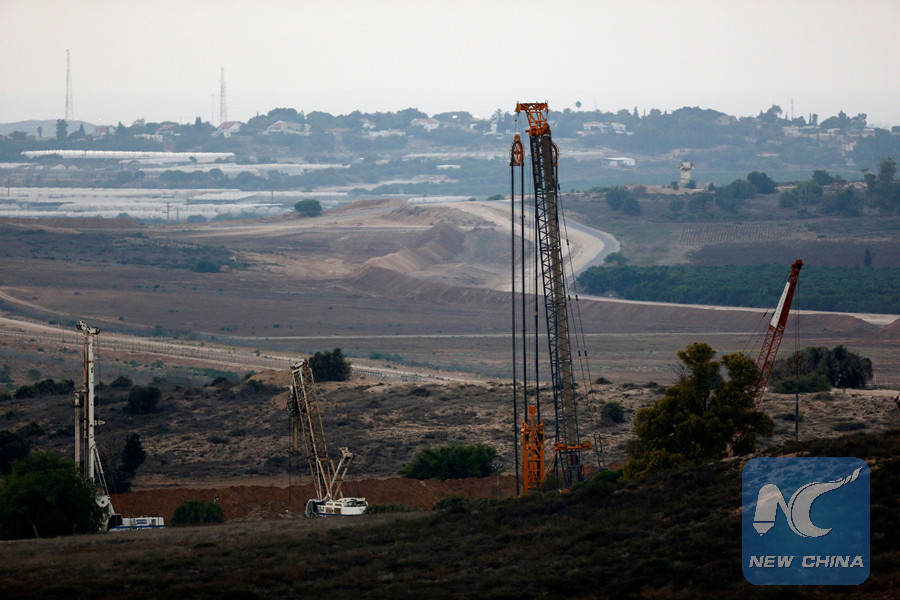
Drills are seen on the Israeli side of the Northern Gaza border near kibbutz Nir Am, Israel August 23, 2016. (Reuters photo)
by Keren Setton
JERUSALEM, Oct. 5 (Xinhua) -- The Israeli kibbutz is considered one of the founding blocks of the small Jewish state.
A collective form of living, traditionally based on agriculture, its residents would pool their incomes and all live equally -- the dairy farmer earning the same as the general manager of the kibbutz.
As Israel became more prosperous and modernized, the values of the kibbutz eroded and members also started leaving.
In the late 1980's, the kibbutz movement was knee-deep into a crisis which had the potential of quelling it completely.
Changes were made and many kibbutzim began working differently -- in many places, members were allowed to keep their salaries, build new homes and lead more individual lives.
The high cost of living in recent years has brought many members who left to come back.
Another major change also emerged -- the urban kibbutz, people who live together in a communal way within an Israeli city.
They work outside of the kibbutz but pool their resources and instead of developing the kibbutz, they help develop the city. They are usually positioned in peripheral areas -- not only geographically, but places with a weak socio-economic profile.
All these factors has contributed to the rehabilitation of Israel's kibbutzim.
According to Gil Lin, this adaptation comes as a response to the changing needs of the Israeli society.
Lin is the deputy secretary general of the Israeli kibbutz movement.
In Israel's early years, the kibbutzim served as pioneers of agriculture in the remote areas they populated. They settled empty places and brought life to areas that were unknown to the new Israelis.
In the past, members of the kibbutz were often considered by Israelis as aloof and condescending.
Perhaps it is the missionary nature of their founding years that helped in creating that image.
The existence of urban kibbutzim is causing a dent in that image.
"The new periphery is a social one. The new place that needs action in the Israeli society is in all kinds of places in cities where there are weaker populations, where there is a need to invest in education, to improve neighborhoods and so on. And in these places the urban kibbutzim enters with the same missionary feeling, with the same strong will to do something, in cooperation and values of equality," Lin says.
Members of the urban kibbutz often work in education and other social professions which benefit the community and the city which they live in.
Migvan Sderot is an urban kibbutz in the southern Israeli city of Sderot. It was established in the late 1980's.
It has approximately 50 members.
Sderot borders with the Gaza Strip and has been the target of thousands of rockets fired by the militant Hamas group which does not recognize the state of Israel.
With a largely socio-economically weak population of approximately 25,000, the city needs strengthening in many areas.
According to it's official website, the members decided on Sderot as their location because they had "a strong desire to live in a small place where they can achieve maximum influence."
Amram Shlomi, a founding member of Migvan Sderot, explains the ideals: "It's the things we want to share -- people from the city and people from the kibbutz together. We can educate our children together, we can do such things together and I think that's the most important thing that we came for."
Life in Migvan Sderot is modest.
"It's not for everyone. It suits only for people that really believe these values. Just if you believe the values, you can share the life together," says Shlomi.
The majority of Israelis live in cities and lead a capitalist life-style.
In Migvan Sderot, like in other urban kibbutz set-ups, the cars and salaries are pooled. Vacations abroad are virtually unheard of and allocation of funds is determined by the group, according to the urgency of people's needs.
"The living is very simple," Shlomi describes.
Yirmi Patishi, another resident, grew up in a traditional kibbutz.
"I saw the beautiful human values in the kibbutz but outside there is a different way of life and I thought -- these values do not belong to the people of the kibbutz, I want to share these values outside of the kibbutz," he explains.
The evolution of the kibbutz has been a complex one.
There are still those who remain traditional, equally sharing all their resources. There are others whose members give a certain percentage of their income to the collective.
Then there is the urban kibbutz which is a completely different model.
This adaptation has guaranteed the survival of the movement for now.
"There is a win-win situation here and everyone is satisfied. I think this is a good model for the kibbutz movement in general. This is actually the next generation of the movement but not instead of it, rather as a completion of it," Gil Lin summarizes.

